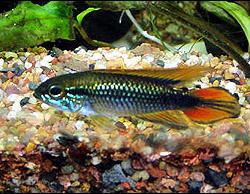Spade Tailed Apisto
Agasizi's Apisto Scientific Name: Apistogramma agassizii
Fri, 18th April, 2025 - 8:18 pm GMT
Sponsor Ads:

Alternative Name
Agasizi's Apisto Scientific Name: Apistogramma agassiziiBasic Info
Males are beautifully colored, their bodies are typically blue, they have red and silver tails, and reddish-orange fins. Females are more drably colored, their bodies being brownish in color, with yellow/red fins and tail. They are classified as dwarf cichlids, usually not exceeding 4 inches in length.
Health
Spade Tailed Apistos can be picky eaters, but will grow to accept a variety of foods including: brine shrimp, bloodworms, tropical flakes, and micro worms. Spade Tailed Apistos will do well in a twenty gallon aquarium with an average pH of 6.6-6.8 , temperatures should be between 75 and 78 degrees Fahrenheit. Spade Tailed Apistos prefer soft water. Driftwood makes a great addition to their tank to soften the water and provide hiding places, peat moss can also be used to soften the water. Breeding Spade Tailed Apistos are typically harem breeders, with one male presiding over several females. When breeding the female turns a yellow color, and will be chased around by the male. Several days later the female will lay eggs on a pre-cleaned flat surface (usually a rock), where she will guard them and chase off any fish that come near (including the male). The eggs take anywhere from 2 to 7 days to hatch dependent on the temperature.Habitat
Fresh water fishBehavior
Unlike most cichlids the Spade Tailed Apisto is not usually aggressive to other fish. The Spade Tailed Apisto is a wonderful addition to any community tank due to its striking colors and entertaining behavior. Spade Tailed Apistos are members of the cichlid family, but do not possess the aggressiveness that is characteristic of most cichlids. Spade Tailed Apistos are timid fish, which will do well in a community tank, often housed alongside danios, guppies and tetras.Origin
South AmericaHistory
Spade Tailed Apistos are relatively expensive at the moment, due in part to the demand for these beautiful fish.Common Foods
N/ASponsor Ads:
"Measurement owes its existence to Earth; Estimation of quantity to Measurement; Calculation to Estimation of quantity; Balancing of chances to Calculation; and Victory to Balancing of chances." -- Sun Tzu, The Art of War
Spade Tailed Apisto
Coded by: BGID® | ALL RIGHTS RESERVED Copyright © 2000-2025
Disclaimer | Privacy | Report Errors / Contact | Credits








 Why haven't we as a collective earth met with aliens yet?
Why haven't we as a collective earth met with aliens yet?  The Best Text Adventure You Will Ever Play! The official site:
The Best Text Adventure You Will Ever Play! The official site:  Homosexual behavior stems from the mind or genetics?
Homosexual behavior stems from the mind or genetics?  World EcoSystem - Biodiversity Changes - Who is on board and who isn
World EcoSystem - Biodiversity Changes - Who is on board and who isn  Mouthwash - Mouthrinse - Mouth Sores - Healing Infections - Gingivitis
Mouthwash - Mouthrinse - Mouth Sores - Healing Infections - Gingivitis  Treatment for Depression
Treatment for Depression  Ultra radical and violent Islamist group that even rivals Al Qaeda
Ultra radical and violent Islamist group that even rivals Al Qaeda  An idea to have teachers who want to carry guns to school undergo some level of police training will be left up to local school districts and police departments.
An idea to have teachers who want to carry guns to school undergo some level of police training will be left up to local school districts and police departments.